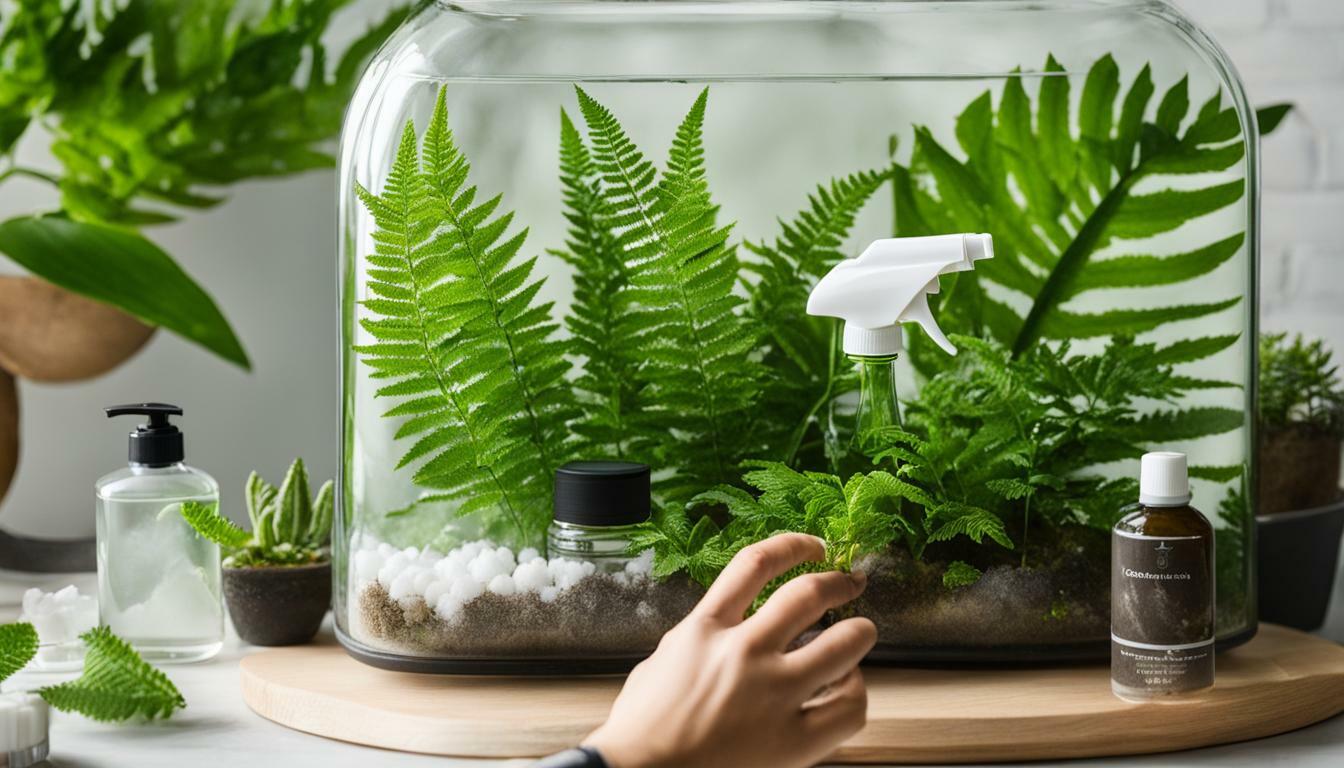Terrarium care is essential for creating a thriving miniature ecosystem. By implementing effective disease prevention strategies, you can ensure the longevity and health of your terrarium. Understanding the settling-in period and the basic needs of the plants is crucial in maintaining a healthy terrarium. Optimizing lighting and temperature, managing condensation, observing and adjusting watering practices, addressing mold and fungus early, and regular cleaning and maintenance are all important aspects of terrarium care.
Key Takeaways:
- Understanding the basic needs of terrarium plants is crucial for their overall health and well-being.
- Optimal lighting and temperature conditions are essential for a thriving terrarium ecosystem.
- Managing condensation levels in terrariums is important to prevent mold and fungal growth.
- Observing and adjusting watering practices based on individual plant needs is vital for terrarium health.
- Addressing mold and fungus early on in terrariums helps maintain a disease-free environment.
By following these disease prevention strategies and implementing regular cleaning and maintenance practices, you can create a successful terrarium that will bring beauty and serenity to your indoor space. Stay tuned for the upcoming sections of this article, where we will delve deeper into each aspect of terrarium care and explore common terrarium issues and solutions.
Understanding the Settling-in Period and Basic Needs of Terrarium Plants
When setting up a new terrarium, it is crucial to understand the settling-in period and provide the necessary conditions for your plants to thrive. Terrarium plants require specific care to adapt to their new environment and establish a healthy ecosystem. Here, we will explore some essential terrarium care tips to help you maintain a healthy terrarium.
Lighting and temperature play a vital role in the growth and well-being of terrarium plants. While they need ample light to photosynthesize, direct sunlight can quickly heat up the terrarium, causing damage to the plants. Therefore, it is best to place your terrarium in a well-lit area away from direct sunlight. This will provide the necessary light while ensuring the temperature remains at an average room level.
Condensation is a natural occurrence in terrariums due to the closed environment. However, excessive condensation can lead to mold and fungal growth, which can be detrimental to your plants’ health. To mitigate this, consider periodically removing the lid for a short period to allow air circulation and reduce condensation levels.
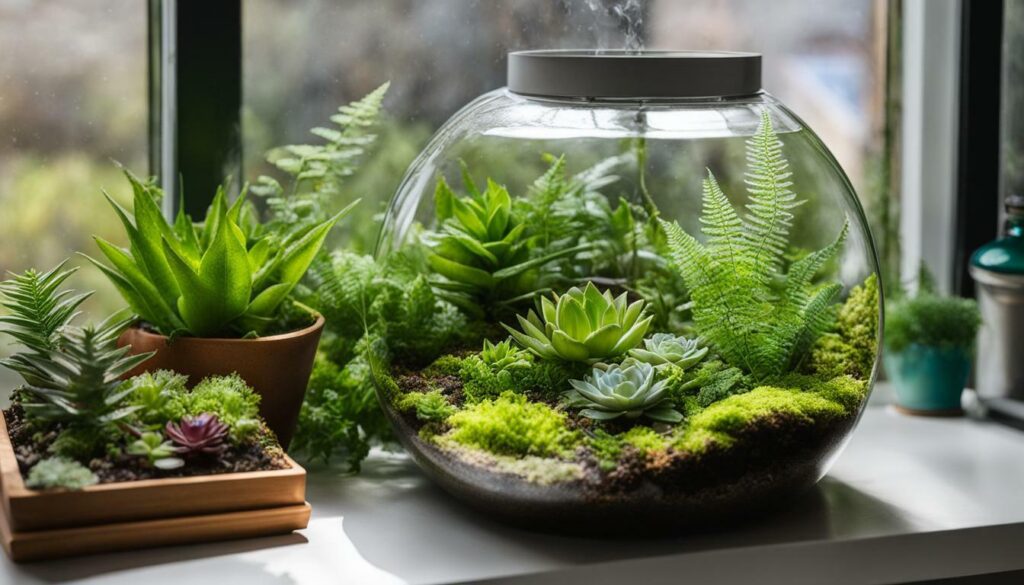
Watering your terrarium is not based on a fixed routine, but rather on the observation of your plants’ moisture needs. It is essential to monitor the soil’s moisture level and water accordingly. Overwatering can lead to root rot and other diseases, so it’s better to err on the side of caution. Remember, each plant has different watering requirements, so it’s crucial to understand the specific needs of the plants in your terrarium.
Another important aspect of terrarium care is addressing mold and fungus. If you notice any signs of mold or fungus, it is crucial to remove it promptly to prevent its spread. Allow for proper air circulation within the terrarium to discourage their growth. Regularly check your plants and soil for any signs of mold, and take necessary actions at the first sight of trouble.
Common terrarium issues can include flies, tall plant growth, white spots on bonsai trees, and weepy, dry plants. It’s vital to address these issues proactively to maintain a healthy terrarium ecosystem. Flies can be managed by keeping the terrarium clean and removing any decaying organic matter. Pruning or trimming plants is necessary to control tall growth and maintain an aesthetically pleasing terrarium. White spots on bonsai trees can be a sign of scale insects, which should be treated with appropriate insecticides. Weepy, dry plants may require more frequent watering or adjustments to the terrarium’s humidity level.
Regular cleaning and maintenance are essential in terrarium care. Removing dead leaves and debris is crucial to prevent the buildup of harmful bacteria and pests. Cleaning the glass regularly ensures optimal light transmission and visibility. By following these terrarium care tips and understanding the annual care needed, you can create a thriving and healthy terrarium ecosystem.
| Terrarium Care Tips | Maintaining a healthy terrarium |
|---|---|
| Understand the settling-in period | Provide optimal lighting and temperature |
| Monitor and adjust watering practices | Address mold and fungus early |
| Deal with common terrarium issues | Regular cleaning and maintenance |
| Ensure annual care for terrariums | Preventive terrarium disease management |
Optimizing Lighting and Temperature for Terrariums
Proper lighting and temperature are vital factors in creating an ideal habitat for terrarium plants. When it comes to lighting, terrariums should be placed in a well-lit area, but not directly exposed to sunlight. This helps prevent overheating and damage to the plants. Natural light is best, but if that is not achievable, artificial lights can be used, such as fluorescent bulbs or LED grow lights. It is important to position the lights at an appropriate distance from the plants to ensure they receive the right amount of illumination. Regularly monitor the temperature in your terrarium to maintain an optimal range for plant growth. Most terrarium plants thrive in average room temperatures, ranging from 60 to 75°F (15 to 24°C). Avoid extreme temperature fluctuations as they can stress the plants. If your terrarium is too cold, consider using a heating mat or placing it near a heat source, but be cautious not to overheat the plants.
| Lighting Tips | Temperature Tips |
|---|---|
| Position terrariums near windows with indirect sunlight. | Maintain an average room temperature between 60 and 75°F (15 and 24°C). |
| Use fluorescent bulbs or LED grow lights if natural light is insufficient. | Avoid extreme temperature fluctuations, which can stress the plants. |
| Adjust the distance between the lights and plants to ensure proper illumination. | Consider using a heating mat or placing near a heat source if the terrarium is too cold. |
“Proper lighting and temperature are crucial for the well-being of terrarium plants. By providing adequate light and maintaining a comfortable temperature, you are creating the perfect environment for their growth and development.”
Remember to regularly monitor the lighting and temperature conditions in your terrarium. Observe how the plants are responding and make adjustments if necessary. It’s important to strike a balance between providing enough light for photosynthesis and avoiding excessive heat that could harm your plants. Ensuring optimal lighting and temperature will contribute to the overall success and health of your terrarium.
Additional Tips for Lighting and Temperature Optimization
- Rotate your terrarium regularly to ensure all sides of the plants receive adequate light.
- Use a thermometer to monitor the temperature inside your terrarium and make any necessary adjustments.
- Avoid placing your terrarium near drafty windows or heating vents, as these can cause temperature fluctuations.
- Consider using a timer for your lighting system to maintain a consistent light schedule.
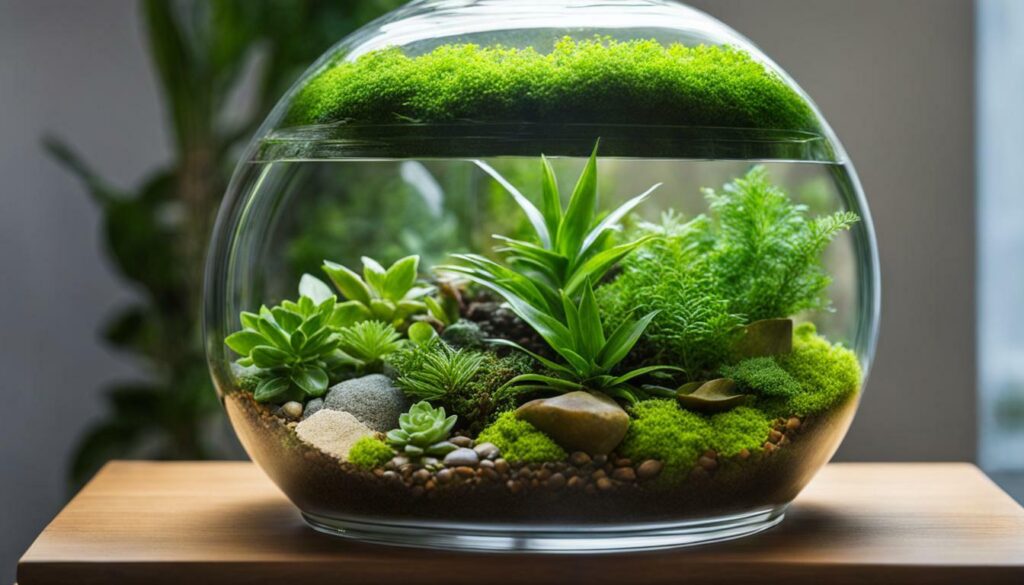
Managing Condensation in Terrariums
Condensation is a natural occurrence in terrariums, but managing it properly is crucial to prevent potential health issues for your plants. While some condensation is normal and even beneficial for creating a humid environment, excessive moisture can lead to mold and fungal growth, which can damage or kill your plants. By following a few simple tips, you can effectively manage condensation and maintain a healthy terrarium ecosystem.
One effective way to reduce condensation in your terrarium is to remove the lid for a short period of time each day. This allows excess moisture to evaporate and helps to regulate the humidity levels inside the terrarium. However, it’s important to monitor the terrarium closely during this time to ensure that the plants do not dry out. If you notice any signs of wilting or dehydration, it’s best to replace the lid immediately and adjust the watering schedule accordingly.
Another strategy to manage condensation is to place a layer of small rocks or pebbles at the bottom of the terrarium. This creates a drainage layer that helps to prevent water from pooling at the bottom and causing excessive condensation. Additionally, positioning the terrarium in a well-ventilated area, away from direct sunlight, can also help to reduce condensation levels.
To maintain a healthy terrarium environment, it’s essential to regularly monitor the condensation levels and make adjustments as needed. By implementing these simple strategies, you can effectively manage condensation and create an ideal environment for your terrarium plants to thrive.
| Condensation Management Tips |
|---|
| Remove the lid for a short period each day to allow excess moisture to evaporate. |
| Place a layer of rocks or pebbles at the bottom of the terrarium to create a drainage layer. |
| Position the terrarium in a well-ventilated area, away from direct sunlight. |
“Managing condensation in terrariums is essential to prevent mold and fungal growth, which can harm your plants. By following a few simple tips, you can create a healthy and thriving terrarium ecosystem.”– Terrarium Care Tips
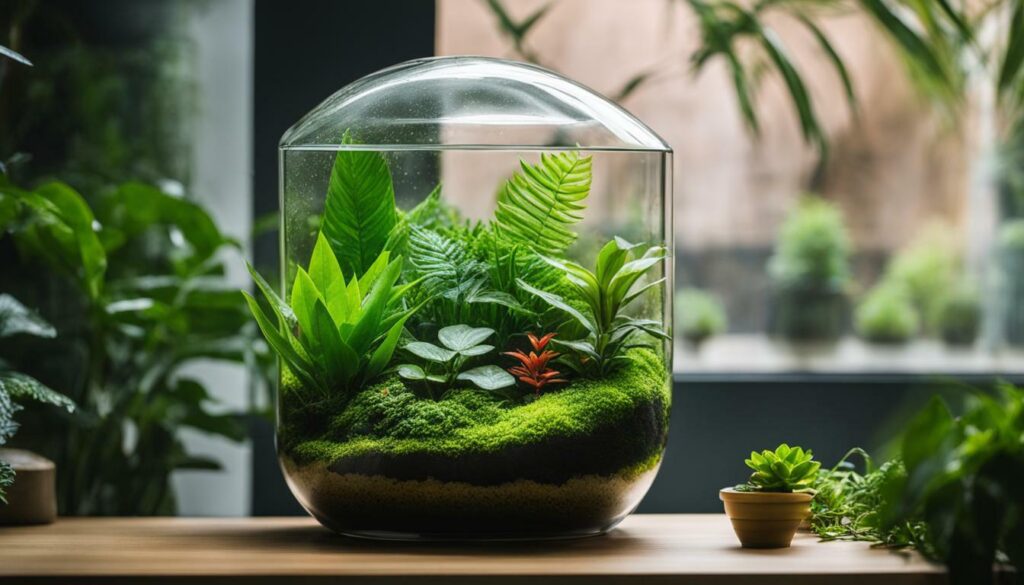
In addition to managing condensation, it’s important to maintain optimal conditions for your terrarium plants. Providing adequate lighting and regulating temperature are key factors in terrarium care.
When it comes to lighting, terrariums should be placed in a well-lit area, but not in direct sunlight. Too much direct sunlight can lead to excessive heat and damage the plants. Instead, choose an area with bright, indirect light, such as near a window or under a grow light.
Temperature is another crucial factor to consider. Most terrarium plants thrive at room temperature, around 70-75°F (21-24°C). Avoid placing your terrarium near air vents or drafty areas, as sudden temperature fluctuations can stress the plants.
By ensuring proper lighting and temperature conditions, along with effective condensation management, you can create a favorable environment for your terrarium plants, promoting their growth and overall health.
Observing and Adjusting Watering Practices
Watering your terrarium correctly is essential for preventing diseases and promoting the overall well-being of your plants. Each plant has its own watering requirements, and overwatering can lead to root rot and other diseases. To maintain optimal plant health, it is important to observe and adjust your watering practices based on the needs of your terrarium.
One way to determine if your terrarium needs watering is by checking the moisture level of the soil. Insert your finger into the soil up to the first knuckle. If the soil feels damp, it indicates that your terrarium has sufficient moisture. On the other hand, if the soil feels dry at that depth, it’s a sign that it’s time to water your plants.
When watering your terrarium, it’s essential to do so gently and evenly to prevent soil compaction and root damage. Pour water slowly over the soil, allowing it to be absorbed gradually. Avoid over-saturating the soil, as excess water can lead to stagnant conditions and the growth of harmful bacteria or fungi.
Remember that the frequency of watering will depend on factors such as the size of your terrarium, the type of plants you have, and the environmental conditions. It’s important to monitor your terrarium regularly and make adjustments as needed. By providing the right amount of water at the right time, you can ensure the health and longevity of your terrarium plants.
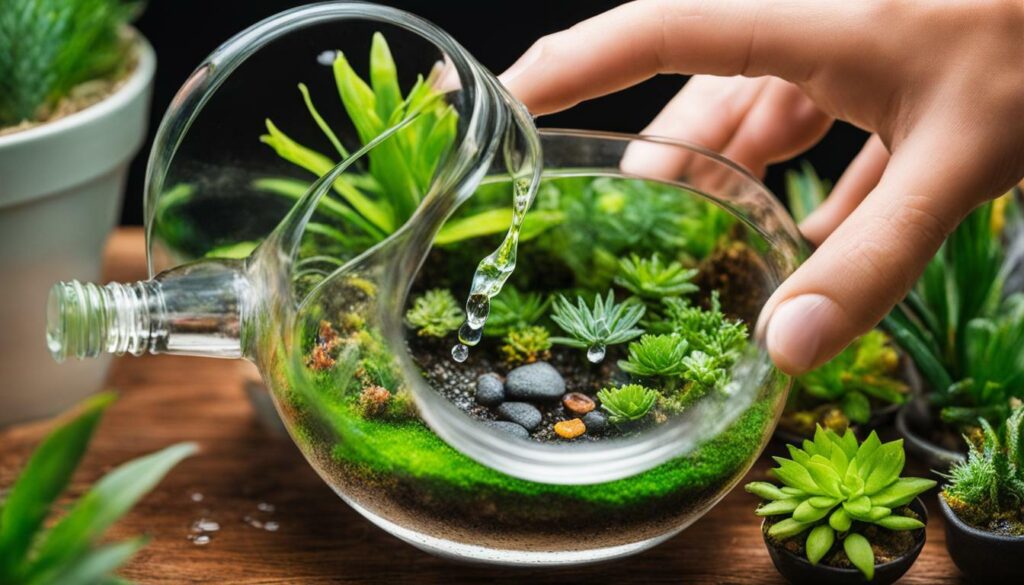
| Plant Type | Watering Frequency |
|---|---|
| Succulents and cacti | Water sparingly, allowing the soil to dry out completely between waterings. |
| Tropical plants | Water moderately, keeping the soil consistently moist but not waterlogged. |
| Mosses and ferns | Mist or spray the plants regularly to maintain a moist environment. |
| Air plants | Soak the plants in water for 15-30 minutes every 1-2 weeks, allowing them to dry completely before returning them to the terrarium. |
By following these watering guidelines and understanding the individual needs of your terrarium plants, you can ensure they receive the proper hydration they require for optimal growth and disease prevention.
Addressing Mold and Fungus Early
Mold and fungus can quickly spread in terrariums, but with early detection and prompt action, you can prevent their detrimental effects on your plants. Terrariums provide a humid and enclosed environment that is favorable for the growth of mold and fungus. These unwanted guests not only hinder the aesthetic appeal of your terrarium but also pose a threat to the health of your plants.
To address mold and fungus issues, it is important to regularly inspect your terrarium for any signs of their presence. Look out for fuzzy growth, discoloration, or a musty odor. If you spot any of these indicators, it’s crucial to act swiftly to prevent further damage.
First, remove the affected areas immediately. This includes removing any infected leaves, decaying matter, or visible fungal growth. Carefully dispose of these materials to prevent the spread of spores. Next, improve air circulation within the terrarium by opening the lid or removing it temporarily. Increased airflow will help reduce the moisture levels and discourage the growth of mold and fungus. Additionally, ensure that your terrarium receives sufficient indirect light to create an environment less favorable for these unwanted invaders.
“Mold and fungus can quickly spread in terrariums, but with early detection and prompt action, you can prevent their detrimental effects on your plants.”
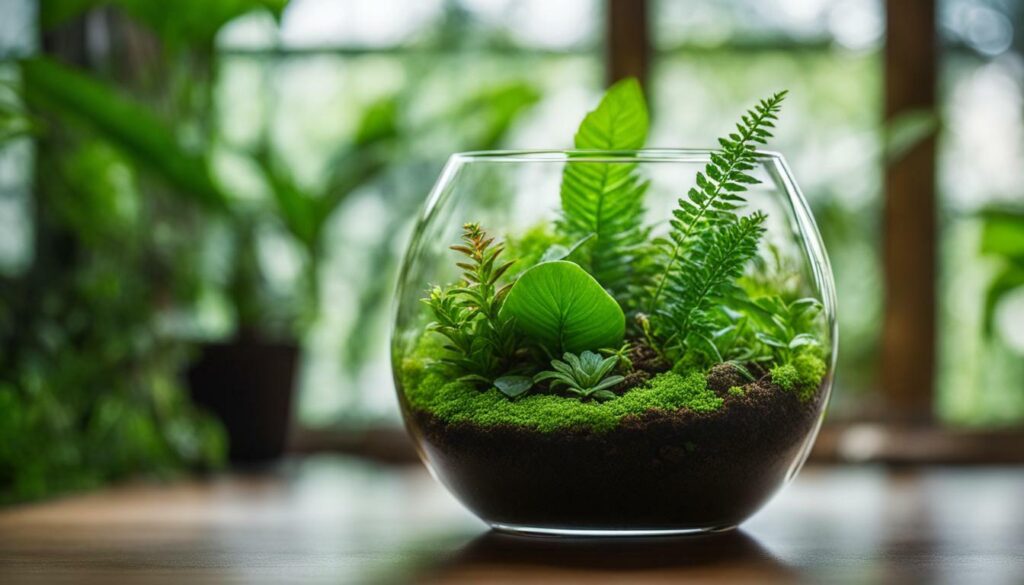
Prevention is always better than cure when it comes to mold and fungus in terrariums. Incorporating these preventive measures into your terrarium care routine will help keep these unwanted invaders at bay:
- Monitor and maintain the moisture levels in your terrarium. Avoid overwatering, as excess moisture creates an ideal breeding ground for mold and fungus.
- Ensure proper drainage in your terrarium to prevent water from accumulating at the bottom. Excess water can lead to stagnant conditions, promoting the growth of mold and fungus.
- Clean your terrarium regularly by removing dead leaves, debris, and decaying matter. These organic materials contribute to the growth of mold and fungus.
- Use a well-draining potting mix specifically designed for terrarium plants. This will help prevent excessive moisture retention.
By following these preventive measures and taking immediate action at the first sign of mold or fungus, you can maintain a healthy and thriving terrarium ecosystem.
| Common signs of mold and fungus in terrariums | Action |
|---|---|
| Fuzzy growth or discoloration | Remove affected areas immediately and improve air circulation |
| Musty odor | Inspect the terrarium for mold or fungus and take appropriate action |
Common Terrarium Issues and Solutions
Although terrariums are relatively low-maintenance, there are common issues that may arise, but with the right strategies, you can effectively manage and prevent them. Here are some of the most common terrarium issues and solutions to help you maintain a healthy and thriving terrarium ecosystem.
Flies
One common problem in terrariums is the presence of flies. These pesky insects can be attracted to the moist environment of the terrarium. To get rid of flies, you can create a DIY fly trap using apple cider vinegar and dish soap. Simply mix equal parts of apple cider vinegar and dish soap in a shallow dish and place it near the terrarium. The flies will be attracted to the scent of the vinegar and get trapped in the soapy solution. Regularly empty and replace the trap to prevent the build-up of flies.
Tall Plant Growth
If you notice that your terrarium plants are growing too tall and leggy, it may indicate insufficient light. Move your terrarium to a brighter location, but avoid direct sunlight as it can cause overheating. You can also trim back the overgrown plants to encourage bushier growth. Remember to research the light requirements of your specific plants to ensure they receive the right amount of light for optimal growth.
White Spots on Bonsai Trees
White spots on bonsai trees in a terrarium can be a sign of mealybugs or scale insects. These pests can be effectively controlled by dabbing them with a cotton swab soaked in rubbing alcohol. Make sure to treat all affected areas, including the undersides of leaves where pests may hide. Regularly inspect your plants for any signs of pests to catch and treat the infestation early.
Weepy, Dry Plants
If your terrarium plants appear weepy and dry, it may be an indication of underwatering. Each plant has its own watering requirements, so make sure to observe and adjust your watering practices accordingly. Check the moisture level of the soil regularly by sticking your finger about an inch deep into the soil. If it feels dry, it’s time to water. Use a spray bottle or watering can with a narrow spout to water the plants gently, making sure not to overwater, as this can lead to root rot.
By being proactive in addressing these common terrarium issues, you can maintain a healthy and thriving terrarium ecosystem. Regularly inspect your terrarium, provide adequate lighting and moisture, and take appropriate measures to control pests. With proper care and prevention strategies, your terrarium will continue to flourish and bring a touch of nature indoors.
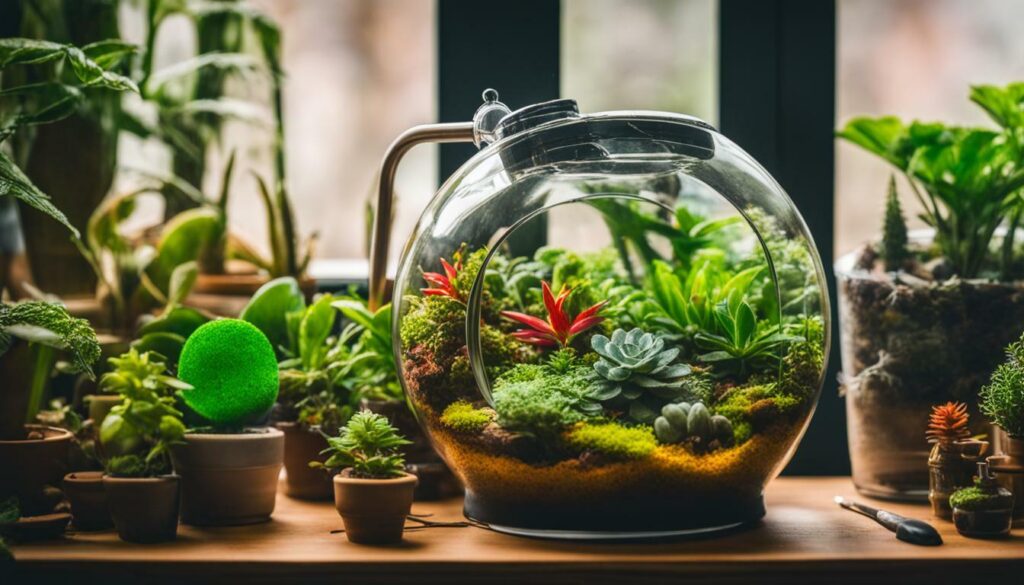
Regular cleaning and maintenance are essential for the long-term health and success of your terrarium. By following these simple tips, you can ensure that your terrarium remains a thriving and disease-free ecosystem.
1. Remove dead leaves: Dead leaves can accumulate in the terrarium and provide a breeding ground for pests and diseases. Regularly check your terrarium and remove any dead or decaying leaves to maintain optimal plant health.
2. Clean the glass: Over time, the glass of your terrarium can accumulate dust, dirt, and water stains, which can obstruct the view and prevent essential light from reaching the plants. Use a soft cloth or sponge to gently clean the glass and improve visibility.
3. Maintain proper humidity: Terrariums thrive in environments with controlled humidity levels. Monitor the humidity inside your terrarium and adjust as needed. If there is excessive condensation, consider removing the lid for a short period to allow for air circulation and reduce moisture buildup.
4. Prune and trim: Regular pruning and trimming of your terrarium plants help maintain their shape and prevent overcrowding. Remove any overgrown or straggly branches to ensure air circulation and prevent the spread of diseases.
Remember, each terrarium is unique, and its maintenance needs may vary. Regularly monitor your terrarium’s condition and make adjustments accordingly. With proper care and attention, your terrarium will continue to flourish, providing a beautiful and healthy environment for your plants to thrive.
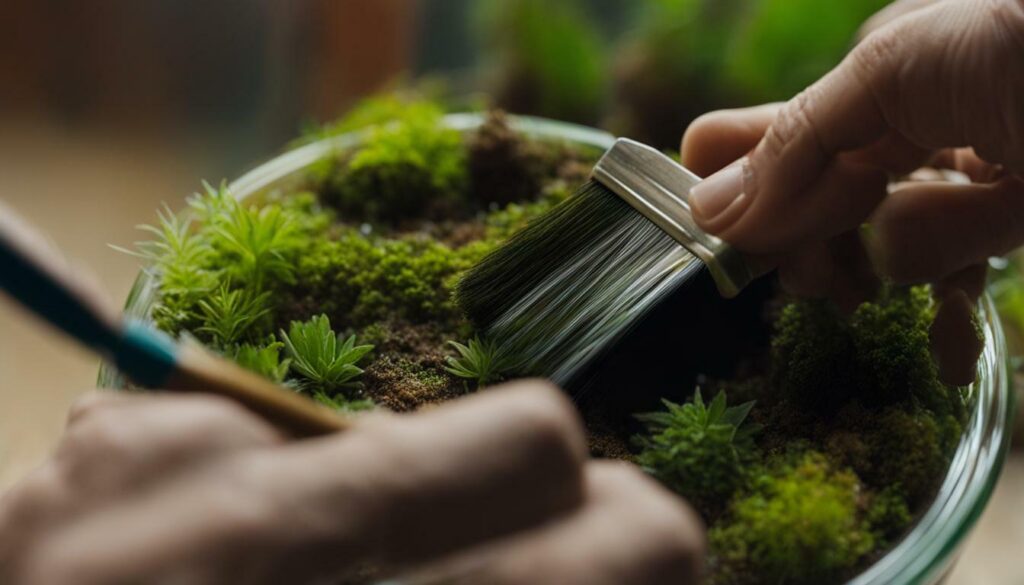
| Terrarium Cleaning Checklist: |
|---|
| Remove dead leaves |
| Clean the glass |
| Maintain proper humidity |
| Prune and trim |
What are the Best Disease Prevention Strategies for Terrarium Care?
When it comes to terrarium care, implementing effective terrarium pest prevention tips is crucial for keeping diseases at bay. Regularly inspecting plants for signs of pests, maintaining proper humidity levels, and using natural pest control methods can help prevent diseases and keep your terrarium thriving.
Understanding Annual Care for Terrariums
Terrariums require specific care throughout the year to maintain their health and vitality. Understanding the seasonal considerations and steps involved will help ensure the continued well-being of your terrarium plants. Here are some essential terrarium care tips for each season:
Spring
In spring, it’s important to check your terrarium for any signs of overgrown or overcrowded plants. If necessary, gently remove and replant them to provide sufficient space for healthy growth. This is also a good time to trim any dead or yellowing leaves and assess the overall condition of your terrarium.
In addition, consider adjusting the watering frequency as the weather warms up. Monitor the moisture levels and water only when the soil feels dry to the touch. Overwatering can lead to root rot and other issues, so it’s crucial to strike the right balance.
Summer
During the summer months, terrariums may be exposed to higher temperatures and increased sunlight. It’s important to monitor the temperature inside your terrarium and make any necessary adjustments to maintain an optimal range for your plants. Direct sunlight should be avoided, as it can cause overheating and damage to delicate foliage.
Regularly check for signs of pests, such as small flies or mites, and take appropriate measures to address the issue. In some cases, introducing natural predators like ladybugs can help keep the pest population under control.
Fall and Winter
As the weather cools down, you may notice a decrease in plant growth and overall activity in your terrarium. This is normal, as many terrarium plants go into a dormant phase during the fall and winter months. Reduce the watering frequency accordingly, ensuring that the soil remains slightly moist but not overly wet.
It’s also important to adjust the lighting conditions in response to the shorter days. Consider placing your terrarium in a well-lit area or supplementing with artificial grow lights to provide adequate illumination for your plants.
| Season | Terrarium Care Tips |
|---|---|
| Spring | Check for overgrown plants and trim dead leaves. Adjust watering frequency. |
| Summer | Monitor temperature and sunlight exposure. Address pest issues promptly. |
| Fall and Winter | Reduce watering frequency and adjust lighting conditions for dormant phase. |
By following these seasonal care tips, you can ensure that your terrarium thrives and remains healthy throughout the year. Remember to observe your plants closely and make any necessary adjustments based on their individual needs. With proper care and prevention strategies, your terrarium will continue to bring beauty and serenity to your living space.
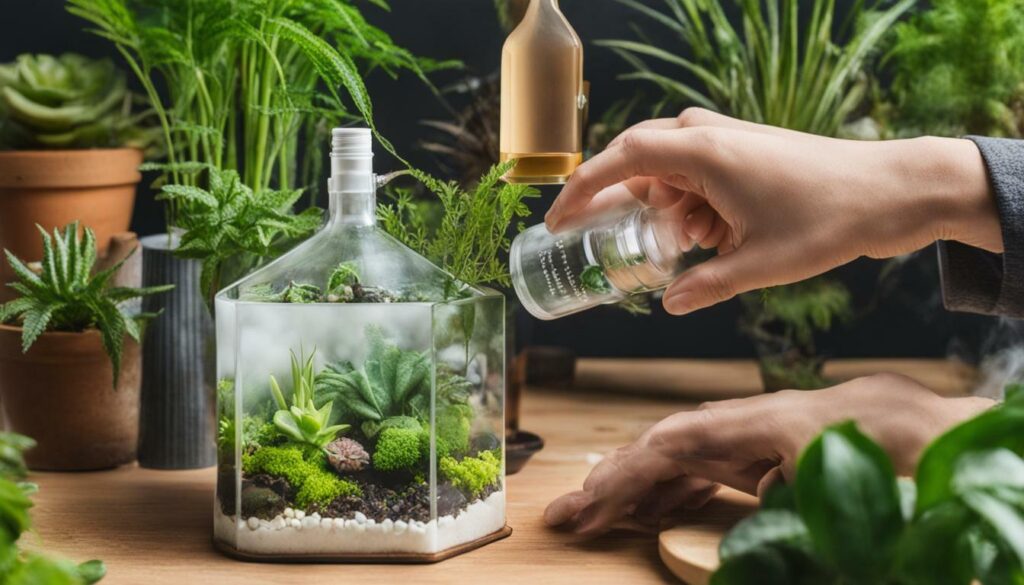
By implementing effective disease prevention techniques and providing proper care, you can create a healthy and vibrant terrarium that will bring joy and beauty to your space.
Mastering terrarium care begins with understanding the settling-in period and the basic needs of the plants. Giving your terrarium time to acclimate and thrive is crucial for long-term success. Pay close attention to lighting and temperature, ensuring that your terrarium is placed in a well-lit area away from direct sunlight and maintaining an average room temperature.
While condensation is normal in terrariums, excessive moisture can lead to mold and fungal growth. To minimize condensation levels, consider removing the lid for a short period of time to allow for air circulation.
Watering your terrarium is not on a set routine. Instead, it should be based on observation of your plants’ needs. Each plant has different watering requirements, so adjusting your watering practices accordingly will help prevent issues like root rot and other diseases.
Addressing mold and fungus early on is crucial for a healthy terrarium ecosystem. If you notice any signs of mold or fungus, promptly remove it and improve air circulation within the terrarium. Additionally, stay vigilant for common terrarium issues such as flies, tall plant growth, white spots on bonsai trees, and weepy, dry plants. These issues can be resolved with proper care and attention.
Regular cleaning and maintenance play a vital role in terrarium care. Be sure to remove dead leaves and clean the glass regularly to minimize the risk of diseases and pests. Lastly, understanding the annual care needed for your terrarium is essential for its continued well-being and growth.
With the right knowledge and consistent care, your terrarium can flourish, offering a miniaturized slice of nature in your own home. Enjoy the process of creating and maintaining your terrarium, and revel in the beauty and tranquility it brings to your space.
FAQ
What are the basic needs of terrarium plants?
Terrarium plants require optimal lighting, temperature, and watering. They should be placed in a well-lit area, away from direct sunlight, and maintained at an average room temperature. Watering should be based on observation of the plants, rather than a set routine.
How can I reduce excessive condensation in my terrarium?
Excessive condensation in terrariums can be reduced by removing the lid for a short period of time. This allows for better air circulation and helps regulate moisture levels in the terrarium.
How should I address signs of mold or fungus in my terrarium?
It is important to address signs of mold or fungus early on in terrariums. If you notice any, remove it immediately and ensure proper air circulation. This will help prevent further growth and maintain a healthy terrarium environment.
What are some common terrarium issues and how can I solve them?
Common terrarium issues include flies, tall plant growth, white spots on bonsai trees, and weepy, dry plants. Flies can be controlled by removing any decaying plant matter. Trim tall plants to maintain the desired size. White spots on bonsai trees may indicate pests, so proper pest control should be implemented. Weepy, dry plants may require more frequent watering or adjustment of the environment to increase humidity.
How should I clean and maintain my terrarium?
Regular cleaning and maintenance are important for terrarium care. Remove dead leaves and clean the glass to maintain a tidy and healthy environment. This helps prevent diseases and pests from affecting the plants in your terrarium.
What annual care do terrariums need?
Terrariums require annual care, including seasonal considerations. This may involve adjusting lighting and temperature for different seasons and providing necessary nutrients or fertilizers. Understanding the specific needs of your terrarium plants is essential for their continued well-being and growth.

